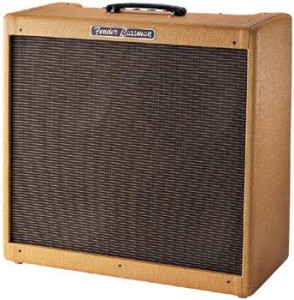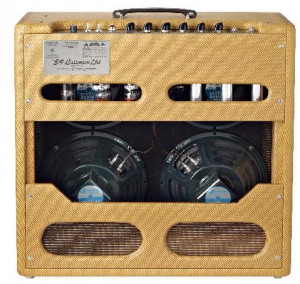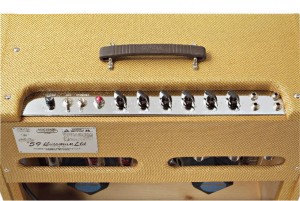 The Fender Bassman evolved as an amplifier designed to initially go along with the Fender Precision Bass. It’s perhaps a bit of an irony that this amp design is among the most revered from guitarists – not bass players. Add to this the fact that the first Marshall amplifiers were largely leveraged from the Bassman’s circuit design (which in turn spawned a countless array of further clones as time passed), and it’s easy to understand why the Fender Bassman was the first amplifier chosen as a tweed reissue in the early ‘90s.
The Fender Bassman evolved as an amplifier designed to initially go along with the Fender Precision Bass. It’s perhaps a bit of an irony that this amp design is among the most revered from guitarists – not bass players. Add to this the fact that the first Marshall amplifiers were largely leveraged from the Bassman’s circuit design (which in turn spawned a countless array of further clones as time passed), and it’s easy to understand why the Fender Bassman was the first amplifier chosen as a tweed reissue in the early ‘90s.
Fender’s new ’59 Bassman LTD reissue takes the amplifier even further (or should we say backward?) closer to the original. Updates for the ’59 Bassman LTD include a tube rectifier (original spec 5AR4), an internal bias pot, a pair of US-made Groove Tubes 6L6-GE output tubes, as well as a quad of Jensen P10R reissue 10-inch Alnico speakers.
To finish up the revised Bassman, the ’59 LTD is housed in a cabinet constructed from solid finger-jointed yellow pine and covered in lacquered Tweed, just like the originals. The front covering is an attractive dark oxblood type cloth- again, like the originals.
Beyond the improvements themselves, the The Fender 59 Bassman LTD shares the same four-input, two-channel design with independent controls for volume on each channel in addition to Presence, Bass, Middle, and Treble controls that go to 12. Each of the two channels (normal and bright emphasized) can be patched together with a short cord to combine the voices. Note that the two channels does not mean that this is a "channel-switching" amp. The ’59 Bassman LTD is rated at 50 watts and certainly puts out the power. This amp is capable of being VERY loud, especially if your interests are in clear clean tones.
 The Bassman design itself is straight up and simple with no preamp gain controls for low-level distortion creation. There are also no effects loops, reverbs, or extra buttons or lights. All said, blues and classic rock players tend to appreciate non-master volume style of amps as the volume can be set to a breakup point of natural distortion and the dynamics can then be controlled by a player’s technique. This touch-sensitivity indeed can really enhance the feel and mood of the music being played. To get an amp like the Bassman to distort, you’ve simply got to turn it up. So that’s exactly what we were looking forward to and exactly what we went to do next.
The Bassman design itself is straight up and simple with no preamp gain controls for low-level distortion creation. There are also no effects loops, reverbs, or extra buttons or lights. All said, blues and classic rock players tend to appreciate non-master volume style of amps as the volume can be set to a breakup point of natural distortion and the dynamics can then be controlled by a player’s technique. This touch-sensitivity indeed can really enhance the feel and mood of the music being played. To get an amp like the Bassman to distort, you’ve simply got to turn it up. So that’s exactly what we were looking forward to and exactly what we went to do next.
Playing the Bassman
I plugged in a variety of Fender Stratocasters including my recently acquired and prized NAMM one-off 1960 Custom Shop Stratocaster Relic in Daphne Blue with matching headstock. I also used my trusty Gibson Les Paul Classic loaded with Seth Lovers (PAF type with alnico II pickups). I ran through some settings as listed on the cardboard promotional piece provided by Fender that gives settings for "cranked up tones"… and it produced o.k. tones and sounds.
Why "just o.k.?" Well, let’s start with the good before we get to the bad with the ’59 LTD. One "good" is that due to the solid-ply cabinet, the added resonance vibration tones that can typically get out-of-control with many combos cranked up is really reduced. In this regard, all the advantages of an open-back combo including the wider special sound dispersion and reflections really can fill up a room nicely.
In addition, the tone controls added quite a bit of range and tonal adjustment – more so than one would expect…
Unfortunately much of that control comes from the top-end frequencies. In other words, the ’59 LTD can be painfully bright when turning it up. Even when turning the Presence and Treble controls to lower settings, this is a bright guitar amplifier…period. At lower and moderate volume settings however, the ’59 LTD produces great chime and bell-tones with a Strat. Bass response is ample and full when the ’59 LTD is set for these milder-clean tones. In fact, with regards to clean tones, the ’59 LTD makes for a really nice, warm Jazz or mild-Blues amp.
When running this amp at volumes above 5 to get the tubes to compress and distort (i.e. what the original 1959 Bassman is famous for!) the ’59 LTD begins to clip and the power output tubes do begin to compress. At this stage, the bass gets fatter, the mids warmer, but the highs are even more emphasized. To compensate for this with the ’59 LTD, I had to decrease the bass and treble controls nearly all the way and I also chose to reduce the presence to avoid the "ice pick" tones that can be found rather easily within the amp otherwise!
Simply put, I really struggled with the "cranked" Fender tones of the ’59 LTD. No doubt that they are much improved over the older Fender Bassman reissue that the ’59 LTD replaces, but not until I ran the treble and presence controls all the way off did I start to get overdriven tones that were fairly even. But then I lost quite a bit of clarity as well – I just couldn’t get the overdriven tone to sound "just right" though I tried every combination I could think of in terms of guitars and settings. There was either too much bite, or I lost clarity and things got a bit muddy. The happy medium was nowhere to be found.
 When using the neck pickup of the Strat at these high volumes, the Jensen P10Rs became quite "woofy" and the resulting overtones aren’t very pleasant.
When using the neck pickup of the Strat at these high volumes, the Jensen P10Rs became quite "woofy" and the resulting overtones aren’t very pleasant.
And while the amp could overdrive quite a bit on its own cranked up, the resulting tones just didn’t do it for me at all and they weren’t as smooth as I would have liked. There was always a feeling of "edginess" to the tone regardless of the control settings and the midrange control didn’t seem to cater to the creamier-midrange stages, but instead seemed to amplify the highs a bit more in areas that weren’t pleasant to hear. Overall, the ’59 Bassman LTD is a bright and punchy amp. Punch can be good, but when overdone, it’s not really what one expects from a tube-rectified blues amp! When I want a punchy amp and tones, I’ll take a Hiwatt Custom 100 for a spin…
I examined the schematic and the Bassman circuit itself is essentially true to the original. But what puzzled me was why the real heavy bluesy warmth just didn’t seem to exist in this amp when turning it up to what should have been the ’59 LTD’s "zone" for best tone when turning up the volume.
As it stands in its current form, Fender’s ’59 Bassman LTD is certainly on the right track. Fender took the time to make some marked improvements to the amp. However, for those looking for the true feel of the classic bluesy original, you may be best suited looking elsewhere.
And while the price is fair for the amp in general in today’s market, the extreme brightness of the amp as well as the stiff feel overall (even though it’s tube rectified!) simply makes it an amp that needs quite a bit of refinement before we can recommend it to our readers. In fact, because of these poor results overall (which surprised us as well truthfully), we were extremely curious to give the Bassman a bit of a workover and we’ll report the findings in the future to see if we can get it to provide the great tones found in the originals.
None of us here like to deliver negative reviews, but at the same time, it would be a disservice to you the reader if we just "sugar-coated" our stories. So let’s give Fender the props for effort and for caring enough to provide products such as the ’59 LTD. But at the same time, let’s encourage them to spend a bit more time in the listening room before releasing an amp such as the ’59 Bassman LTD.
Great review…I’ve had the same experience
with these amps….
Awesome review, I have had the same problem with my Bassman, I usually try to keep the volume at 4-5 and use a Keely Katana clean boost to add the extra volume without the added brightness. It does sound AMAZING with my tube screamers though. I like the Blues Jr. a lot and the Super Reverb as well with those pedals.
Tube Screamers and Fender amps are made for each other aren’t they? Thanks for the comment and coming to the site.
I’d be curious to hear what you think of the “newer” ’57 Bandmaster custom RI. I’m in the market for a good Fender tweed combo! Just reading about the specs and tuning into youtube videos of the Bandmaster, it seems promising and perhaps they took your advice!!
David when will you have the resjltsbto give this amp a truer vintage sound?
David when will you have the results for the improvements?
Hi Peter – thanks for your query. Life circumstances impacted me (note that the site didn’t have fresh content for several years) and I was never able to complete the article. That said, I DID spend time with the Bassman LTD personally after the initial article was posted. To make the longer story short, the biggest improvements needed to that circuit are a change of the horrid Jensen reissue speakers and a swap of the output transformer. I recommend a smooth-coned Weber ceramic reissue based on the original Jensen design. Alnico is o.k. too, but in my view, this circuit with good ceramic speakers will contribute to a bigger tonal range with nicer mids and feel. If you run the amp loud for overdriving it naturally, a Mercury Magnetics ToneClone series output transformer will make a big difference in the tone. Remember, the output transformer is the final link between your tubes and the speakers. And when you turn up the amp, it provides the tonal saturation that tubes often get the credit for. You could go beyond this as far as modifications and change the choke and power transformer as well, but I don’t feel that it’s necessary. If you keep the amp at low to moderate settings and use pedals for overdrive, you may be happy enough with simply changing the speakers.
Thank you for the honest review. I play mostly Gretsch guitars and the ‘holy grail’ – Setzer, Duane Eddy, Cochrane and many others is to pair a Gretsch with a Bassman
A guy is selling a 59 RI for $650 near me. I’m going to try it out and I will keep in mind what I read here.
Great review
I may go instead for a Vox, Fender Deville, or Egnater
The ‘real’ Bassmans have skyrocketed out of my range. If I’m going to spend 2k, I’ll get me a 6122 59 Country Gentleman !!
Note that Setzer’s Bassman is the later circuit which has the piggyback configuration with the head and separate Fender closed-back cabinet. A closed back cabinet will have a fuller frequency response of tone that you will hear and the definition is better on the low end frequencies vs the early tweed Bassman open-back. The tradeoff is that an open-back will have “wider” spread of sound as it disperses in many directions. The phase cancellations that occur from that spread of sound is a negative though… I generally prefer closed back systems as the speakers also don’t tend to “flub” out on the lows as often as they would in a typical open-back combo. The fact that a closed back sealed enclosure provides some pressure against the cone as it moves air in the cabinet is helpful as well. Good luck!!
I think this is a very fair review. I find in my gigging environment that I don’t get it much above 4 to be honest. And I think that is the sweet spot. I use pedals for my overdrive and the amp is fantastic for that. I’ve only cranked it once in the past but a nice well rounded clean amp is what I use it for and then use a Truetone Double Trouble (808 type circuit) and a Lovepedal Kalamazoo with a Sheraton and A Telecaster.
I bought a ‘59 Bassman LTD (Blondeman Limited Edition) in
August 2015, and think it is the best amp I have ever played through. Forget
trying to crank it to get overdrive, though it is quite capable in that role.
The key to unlocking the best of this amplifier is cranking the midrange to 10 or more and using the normal channel , at a volume right around 3. I
thought the same as the author and others on this site for a couple of months
regarding a trebly, brittle sound. However, the tone stack is deceiving. Even
with the midrange cranked and the other tone controls around halfway, it is
still even in terms of frequencies. Use a Marshall Guv’nor Plus (no longer
made) for overdrive, you get the magic Fender cleans with growling, punchy,
tight Marshall overdrive from the pedal. In this configuration, it narrowly
beats my 1994 USA-made Blues DeVille, and makes other amps sound cheap. Try
this combination and watch people with Mesas, Marshalls, Blackstars and other
Fenders turn green with envy.
Thanks for the comments and feedback. Indeed, Fenders are fantastic with pedals (for example, we loved the pre-CBS ’64 Super Reverb run clean with just about any distortion in front of it). The ’59 Bassman LTD’s weakest link are its speakers. It’s been a long time since that review, but the magic of the original Bassman is in its ability to overdrive on its own and just be given a little push to get a growling fat overdriven tone. The LTD just isn’t setup to do what the originals can and again, I put most of the blame on the speakers (other details like the components, etc. are just relatively minor details). Bottom line is you’ve found an amp that works for you and that’s what counts!